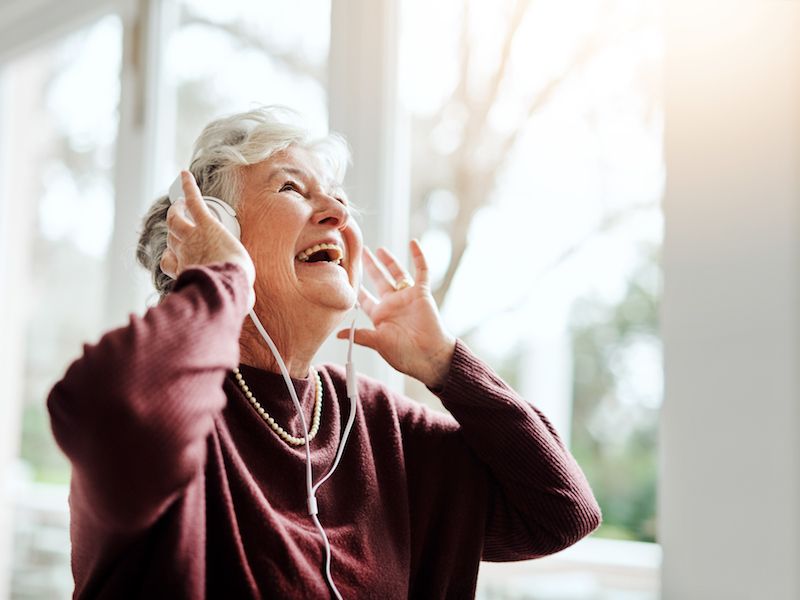
People who work in loud settings such as construction sites or at heavy metal concerts are not the only people affected by noise related loss of hearing. Recreation related noise exposure can be just as damaging as work related noise exposure. What kind of exposure are we dealing with? Music, gaming, streaming video or anything that you would listen to through headphones or earbuds.
You may not realize your smartphone or tablet can go that loud. But these devices can achieve sustained volumes of over 105 dB, which is around the ordinary human pain threshold. This is the volume at which noise begins to literally hurt your ears. So what’s the solution for safeguarding your hearing against volume related damage.
It’s important here to consider the volume. Listen with the volume at no more than 60% for no more than 60 minutes at a stretch (how long you listen for also makes a difference), this is called the 60/60 rule.
Your Hearing Aids Can be Set up For Listening to Music
If you have hearing aids, you’re likely streaming your device directly to your hearing aids, so be sure the volume is not too loud or that you’re not trying to drown out other noises with your music. And there are better ways to listen to music so consult us about that also. Hearing aids aren’t designed to make music clearer like they do with voices so if really like music, you may have observed this. While enjoying music, we can probably make some modifications to help enhance the sound quality and decrease the feedback.
What Are The Best Headphones For You?
If you don’t use hearing aids, there are lots of options for purchasing headphones. There are various things to think about, even though it’s largely a matter of personal preference.
Over-the-Ear Headphones
Over the ear headphones are becoming popular again but you probably won’t see the old foam covered speakers that once came with a walkman. They have lots of choices in style and color, are usually endorsed by celebrities, and can be surprisingly pricey. And these headphones go over the entire ear limiting unwanted sound, unlike those old foam ones.
Conventional perception is that these are safer than in-ear headphones because the source of the sound is further from your eardrum. But because the speakers are bigger they are often capable of much louder sound level. Noise cancellation can be a good thing as long as you’re not losing useful sounds like an oncoming car or truck. But on the positive side, you don’t have to contend with outside noise so you can listen to your music at lower levels.
Earbuds
The normal earbuds are well known for inferior quality of sound, even though lots of people still use them because hey, they came with the phone. In addition, with newer devices that lack a headphone jack, staying with Apple’s earbuds can simply be easier.
The drawback, aside from the poor sound quality, is that basic earbuds can’t block outside noises, so you’re more likely to crank up the sound level. Again, though it’s commonly said that earbuds are problematic because you put them into your ear so their speakers are extremely close to your eardrum, volume is really the biggest problem.
Earbuds That Block External Noise
More comfortable than regular earbuds, models with a round rubber tip are the choice of many people because they help obstruct outside sound. A seal that blocks outside noise from getting in is formed by the rubber tip which conforms to the shape of the ear. But these earbuds can also block out noises you need to hear and volume is still the main issue. And if you use hearing aids, clearly these won’t work for you.
You may have to test out more than one pair before you find headphones that meet your requirements. Your expectations, acoustically, will vary depending on what type of usage you normally give them. The significant thing is to seek out headphones that make it comfortable for you to enjoy at a safe and secure volume.
How to Make Certain Your Hearing is Protected
How can you be sure it’s safe? There’s an app for that…If you have a smartphone, you can download the National Institute for Occupational Safety and Health’s free Sound Level Meter app. There are other apps you can get, but research has found that the dependability of these other apps is hit-and-miss (in addition, for reasons yet unknown, Android-based apps have proven to be less reliable). That prompted NIOSH to create their own app. You can measure outside sounds using the app, but sounds coming out of your device’s speakers can be measured too, essentially, the true volume of what’s being sent to your ears. It’s a little bit of effort, but taking these kinds of preventative steps can help safeguard your hearing.